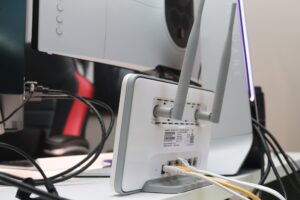
How to Reduce WiFi Problems: Four Common Issues Eliminated with WiFi Automation

There are two things we can all agree on:
- WiFi networks are the foundation of most business operations
- WiFi problems are a pain and cause significant losses in productivity and revenue
Different studies have shown that WiFi performance issues can result in each employee losing almost an hour a week of productivity. Depending on how many employees your company has, that could come out to a day or more of downtime every week of the year. Not only is this bad for operations and your bottom line, it can also harm reputations with customers, and, if bad enough, lead to employees seeking other jobs.
The good news is that there is another way and it doesn’t require hiring expensive consultants or adopting complex technologies. AI-powered WiFi automation platforms can seamlessly identify and prevent WiFi network issues and save companies time and money. In this article, we’ll explore what causes WiFi issues, some of the most common problems, and how exactly WiFi automation provides WiFi assurance and protects operational efficiency.
What causes WiFi issues?
As any IT professional will tell you, there are many factors that can contribute to WiFi performance and behavior problems. These include:
- Network congestion: If there are too many transmissions traveling through the RF environment, user experience will suffer as users face higher latency, slower speeds, and frequent disconnects. Congestion can be caused by overcrowded networks, co-channel interference (CCI), and adjacent channel interference (ACI).
- Interference and Poor Signal Strength: Even if a network isn’t congested, performance can still suffer because of interference and poor signal strength. Signal strength can be affected by physical obstacles like walls or racks of products in a warehouse; and interference can come from electronic devices, such as APs (CCI and ACI), microwaves, or cordless phones.
- Configuration issues: These issues can be anything from mismatched security protocols to improperly configured channels. Configuration issues can cause connectivity problems as devices struggle to effectively communicate with each other.
- Outdated equipment: Most WiFi equipment needs to be updated every 3-5 years. Older pieces of infrastructure may not support the latest WiFi technology.
- Unsuitable number of Access Points: If there are too many APs on a network, this can cause congestion. If there are too few, devices will experience high latency and poor connectivity.
What are four common WiFi problems?
Here are four common problems caused by these issues:
- Slow or inconsistent speeds: A frustrating problem for all users, slow or inconsistent speeds can be caused by the adoption of new applications without new upgrades to support the technology; an equipment failure; hotspots joining the network and using bandwidth; or a number of other factors.
- Weak signals / dropped connections: Many times users complain of signals that randomly drop or become weak. This usually doesn’t affect an entire office space, rather one or two smaller areas. The problem can be caused by physical or electronic interference.
- Server issues: The DNS and DHCP servers are two of the most important pieces of infrastructure in any organization. If there are issues with the servers, users will be unable to view web pages, and will experience failed connections and long connectivity times.
- Poor video quality: More and more offices use video conferencing throughout the work day. Issues such as high jitter and latency or dropped packets will impact the connectivity, availability, and performance of video conferencing applications.
The one thing all WiFi network problems have in common is that they can have multiple causes. Identifying the cause is always necessary before the problem can be resolved. This can be a difficult and time consuming task. To simplify matters, IT professionals can use an AI-powered WiFi automation platform.
WiFi assurance and automation: the key to improved operational efficiency
IT professionals need constant visibility and proactive insights into network performance in order to reduce WiFi problems and maintain optimal user experience. Here’s how AI-powered WiFi automation platforms help:
- Proactive problem identification: With their AI engines, these platforms learn to recognize normal and abnormal behavior across the entire RF environment. If anything goes wrong, the platforms will proactively identify the problem and root cause, and automatically alert IT, often before end users are ever impacted.
- Real-time analytics: Platforms can keep eyes on the network 24/7, whether there are 5,000 or 50,000 connected devices. All traffic is analyzed in real-time, eliminating network mysteries.
- Historical analytics: Long-term trends are just as important to network health as real-time data. WiFi automation platforms can automatically save historical analytics such as end user quality metrics and wireless traces, as well as identify long-term trends for improved future-proofing.
- Automated troubleshooting: With remote capabilities and automated troubleshooting, these platforms support IT in solving problems from any location at any time. This significantly reduces resolution times and saves money by decreasing remote site visits.
- Consistent testing: With proactive, consistent testing, IT teams are always aware of real-time WiFi network performance and behavior. This significantly reduces the chances that an issue will go undetected until it starts causing problems for users. By detecting issues earlier, IT can solve them before productivity is hurt.
Enterprises that use these platforms see enhanced user experience and increased operational efficiency. If that’s something you could use in your business, ask us about our free demo and trial.


